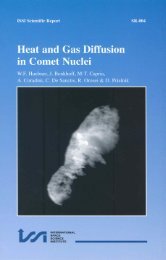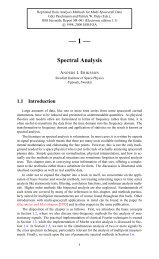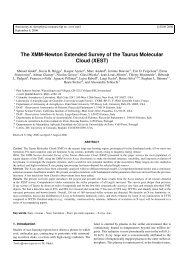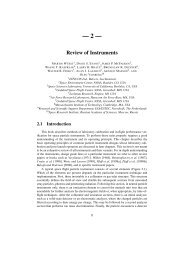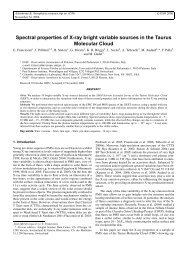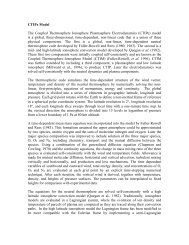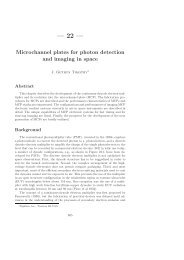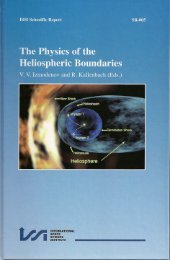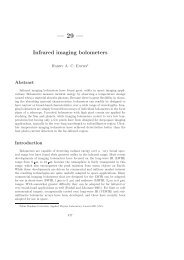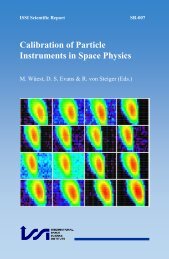Einstein in Bern: The Great Legacy - ISSI
Einstein in Bern: The Great Legacy - ISSI
Einstein in Bern: The Great Legacy - ISSI
Create successful ePaper yourself
Turn your PDF publications into a flip-book with our unique Google optimized e-Paper software.
INTERNATIONAL<br />
SPACE<br />
SCIENCE<br />
INSTITUTE<br />
SPATIUM<br />
Published by the Association Pro <strong>ISSI</strong> No. 18, February 2007<br />
SPATIUM 18
Editorial<br />
Omnia rerum pr<strong>in</strong>cipia parva sunt.<br />
<strong>The</strong> beg<strong>in</strong>n<strong>in</strong>gs of all th<strong>in</strong>gs are<br />
small.<br />
This famous quote of Marcus Tullius<br />
Cicero is more than true for the<br />
middle drawer of an ord<strong>in</strong>ary desk<br />
at the Kramgasse 49 <strong>in</strong> <strong>Bern</strong>. This<br />
drawer was called the office for theoretical<br />
physics by its owner, clearly<br />
a euphemism <strong>in</strong>itially, but more<br />
than appropriate by the time when<br />
its contents prompted noth<strong>in</strong>g less<br />
than a revolution of theoretical<br />
physics.<br />
<strong>The</strong> desk belonged to the patent<br />
clerk of third rank Albert <strong>E<strong>in</strong>ste<strong>in</strong></strong>,<br />
who dur<strong>in</strong>g the office hours had to<br />
treat the more or less <strong>in</strong>genious <strong>in</strong>ventions<br />
filed to the Patent Office,<br />
while <strong>in</strong> his spare time had set out<br />
to <strong>in</strong>vent a new physics.<br />
One might expect that such highfly<strong>in</strong>g<br />
studies could at best occupy<br />
a few scientists <strong>in</strong> their laboratories.<br />
It was worse off: even the brightest<br />
representatives of the worldwide<br />
science community needed at<br />
least twenty years to fully grasp the<br />
epochal power of the patent clerk’s<br />
ideas while for the great public <strong>E<strong>in</strong>ste<strong>in</strong></strong>’s<br />
theories cont<strong>in</strong>ue to stand for<br />
the <strong>in</strong>accessibility of science.<br />
Nevertheless, much has been said<br />
about Albert <strong>E<strong>in</strong>ste<strong>in</strong></strong> on the occasion<br />
of the hundredth anniversary<br />
of the annus mirabilis 1905 <strong>in</strong> <strong>Bern</strong>,<br />
the year, when the middle drawer<br />
of his desk became really the office<br />
for theoretical physics. Rudolf von<br />
Steiger, Professor at the University<br />
of <strong>Bern</strong> and Director of the International<br />
Space Science Institute together<br />
with Thomas H. Zurbuchen,<br />
Associate Professor at the University<br />
of Michigan have endeavoured<br />
successfully to translate the fasc<strong>in</strong>at<strong>in</strong>g<br />
ideas of Albert <strong>E<strong>in</strong>ste<strong>in</strong></strong> for a<br />
larger audience, not just <strong>in</strong> <strong>Bern</strong>, but<br />
<strong>in</strong> many stations all over the world<br />
and to highlight some of the traces<br />
he cont<strong>in</strong>ues to leave <strong>in</strong> our daily<br />
life. We are greatly <strong>in</strong>debted to the<br />
authors for their k<strong>in</strong>d permission to<br />
publish herewith a revised version<br />
of their multi-media presentation.<br />
Hansjörg Schlaepfer<br />
Brissago, January 2007<br />
Impressum<br />
SPATIUM<br />
Published by the<br />
Association Pro <strong>ISSI</strong><br />
Association Pro <strong>ISSI</strong><br />
Hallerstrasse 6, CH-3012 <strong>Bern</strong><br />
Phone +41 (0)31 631 48 96<br />
see<br />
www.issibern.ch/pro-issi.html<br />
for the whole Spatium series<br />
President<br />
Prof. He<strong>in</strong>rich Leutwyler<br />
University of <strong>Bern</strong><br />
Layout and Publisher<br />
Dr. Hansjörg Schlaepfer<br />
CH-8173 Neerach<br />
Pr<strong>in</strong>t<strong>in</strong>g<br />
Stämpfli Publikationen AG<br />
CH-3001 <strong>Bern</strong><br />
Front Cover<br />
This composite image provides a<br />
glimpse to the remotest regions of<br />
the universe explored by the Hubble<br />
Space Telescope so far. <strong>The</strong> evolution<br />
of the cosmos is certa<strong>in</strong>ly a<br />
topic that Albert <strong>E<strong>in</strong>ste<strong>in</strong></strong> discussed<br />
with his two colleagues of the Akademie<br />
Olympia <strong>in</strong> <strong>Bern</strong>, Conrad<br />
Habicht and Maurice Solov<strong>in</strong>e. <strong>The</strong><br />
overlay image shows an excerpt of<br />
a message he wrote to the latter.<br />
(Credit: ESA, NASA, Hansjörg<br />
Schlaepfer)<br />
SPATIUM 18
<strong>E<strong>in</strong>ste<strong>in</strong></strong> <strong>in</strong> <strong>Bern</strong>: <strong>The</strong> <strong>Great</strong> <strong>Legacy</strong> 1<br />
Thomas H. Zurbuchen, University of Michigan, Ann Arbor, MI, USA<br />
Rudolf von Steiger, International Space Science Institute, <strong>Bern</strong>, Switzerland<br />
Brian Grimm, Paper Card<strong>in</strong>al Design, Oakland, CA, USA<br />
Introduction<br />
<strong>The</strong> French philosopher and mathematician<br />
Henri Po<strong>in</strong>caré 2 , <strong>in</strong> 1902,<br />
published a book entitled “La Science<br />
et l’Hypothèse”. In this book<br />
he identified what were – <strong>in</strong> his<br />
op<strong>in</strong>ion – the most important unsolved<br />
problems <strong>in</strong> science. One<br />
problem concerned the way light<br />
<strong>in</strong>teracts with metal surfaces and<br />
obviously is able to eject electrons<br />
out of these surfaces. <strong>The</strong> second<br />
problem had to do with the apparently<br />
random zig-zag motion of<br />
pollen observed under the microscope,<br />
called Brownian Motion. <strong>The</strong><br />
third problem was the failure of experimental<br />
physics to detect how<br />
light propagates, for example, from<br />
stars to astronomical telescopes. <strong>The</strong><br />
assumption of a th<strong>in</strong>, nearly massless<br />
ether had been questioned by<br />
an experiment by Michelson and<br />
Morley some 25 years earlier that<br />
failed to f<strong>in</strong>d any evidence for such<br />
an ether.<br />
Only a few years later a young patent<br />
clerk by the name of Albert <strong>E<strong>in</strong>ste<strong>in</strong></strong><br />
had solved all three of these<br />
problems <strong>in</strong> a conv<strong>in</strong>c<strong>in</strong>g manner.<br />
Figure 1: Beautiful <strong>Bern</strong>. Look<strong>in</strong>g over the roofs of downtown <strong>Bern</strong> to the hills of the <strong>Bern</strong>ese Mittelland to the permanently<br />
snow-covered High Alps with the Blüemlisalp <strong>in</strong> the centre. (Credit: <strong>Bern</strong> Tourism, <strong>Bern</strong>)<br />
1<br />
<strong>The</strong> present text follows a lecture by R. von Steiger <strong>in</strong> the Historisches Museum <strong>in</strong> <strong>Bern</strong>, 22 August 2006. Similar talks were held<br />
by T. Zurbuchen and R. von Steiger <strong>in</strong> over 20 locations world-wide<br />
2<br />
Jules Henri Po<strong>in</strong>caré, 1854 Nancy, France – 1912 Paris, French mathematician, physicist and philosopher.<br />
SPATIUM 18
Sett<strong>in</strong>g the<br />
Stage<br />
<strong>The</strong> story plays <strong>in</strong> <strong>Bern</strong>, the capital<br />
of Switzerland, <strong>in</strong> the very heart of<br />
Europe. <strong>The</strong> historical roots of <strong>Bern</strong><br />
date back to the La Tène time, the<br />
5 th to 1 st centuries B.C. Modern<br />
<strong>Bern</strong> was founded by Duke Berchtold<br />
V von Zähr<strong>in</strong>gen <strong>in</strong> 1191.<br />
A legend tells us that he decided to<br />
name the new city after the first animal<br />
he would catch on a hunt; this<br />
was a bear, prompt<strong>in</strong>g him to name<br />
the place <strong>Bern</strong>. <strong>Bern</strong> is considered<br />
one of the most beautiful cities <strong>in</strong><br />
Europe. It is located close to the<br />
Aare, a river orig<strong>in</strong>at<strong>in</strong>g <strong>in</strong> the Swiss<br />
Alps that br<strong>in</strong>gs clean water from<br />
the mounta<strong>in</strong>s to the city. Naturally,<br />
the U-shaped river bend was an attractive<br />
location for the city <strong>in</strong> medieval<br />
times, provid<strong>in</strong>g protection<br />
from three directions. Today, <strong>Bern</strong><br />
houses approximately 150,000 people.<br />
To outsiders, <strong>Bern</strong> is known for<br />
its history, spann<strong>in</strong>g many centuries,<br />
its bear pit hous<strong>in</strong>g the animal also<br />
found <strong>in</strong> the <strong>Bern</strong> flag, and its ambiance<br />
that is certa<strong>in</strong>ly unrivalled.<br />
To its visitors, <strong>Bern</strong> is often described<br />
as “gemütlich” – you immediately<br />
feel the warmth of its people,<br />
and its beauty.<br />
Figure 2: <strong>Bern</strong>, Kramgasse 49. It is here that the <strong>E<strong>in</strong>ste<strong>in</strong></strong>s lived between 1903<br />
and 1905. From this house Albert <strong>E<strong>in</strong>ste<strong>in</strong></strong> revolutionized physics by his publications<br />
<strong>in</strong> 1905. (Credit: <strong>E<strong>in</strong>ste<strong>in</strong></strong>haus <strong>Bern</strong>)<br />
In the old part of the city, <strong>in</strong> a<br />
house whose orig<strong>in</strong>s date back to<br />
the first city expansion <strong>in</strong> 1218, a<br />
story unravelled that was so groundbreak<strong>in</strong>g<br />
and new that it still has<br />
effects today. In this house at Kramgasse<br />
49 3 (Figure 2) Albert <strong>E<strong>in</strong>ste<strong>in</strong></strong><br />
lived from October 1903 to May<br />
SPATIUM 18
1905. It was one of the seven different<br />
locations where he resided dur<strong>in</strong>g<br />
his seven year stay <strong>in</strong> <strong>Bern</strong>.<br />
For all practical purposes, th<strong>in</strong>gs did<br />
not go very well dur<strong>in</strong>g that time.<br />
He had f<strong>in</strong>ished his exams, allow<strong>in</strong>g<br />
him to submit a doctorate at the<br />
University of Zurich. Out of the<br />
three graduat<strong>in</strong>g students apply<strong>in</strong>g<br />
for a doctorate, two were hired as<br />
teach<strong>in</strong>g assistants, but <strong>E<strong>in</strong>ste<strong>in</strong></strong> was<br />
not. He was married to Mileva<br />
Maric and they had a child, so the<br />
sheer economical necessities forced<br />
him to accept a job at the “Amt für<br />
geistiges Eigentum” – the Swiss office<br />
for <strong>in</strong>tellectual property, or, as<br />
we now call it, the Patent Office.<br />
He was hired as a clerk of third rank.<br />
<strong>The</strong> office hours were from 7 a.m.<br />
to 6 p.m. every work<strong>in</strong>g day and<br />
from 7 a.m. to 5 p.m. on Saturdays.<br />
Only Sundays were off. <strong>The</strong> <strong>E<strong>in</strong>ste<strong>in</strong></strong>s<br />
shared the kitchen and the<br />
bathroom with four other families,<br />
while their own apartment conta<strong>in</strong>ed<br />
two rooms and a foyer. Noth<strong>in</strong>g<br />
of this simple sett<strong>in</strong>g revealed<br />
that here one of the most <strong>in</strong>genious<br />
human spirits ever silently was at<br />
work. And his objective was noth<strong>in</strong>g<br />
less than to answer the three major<br />
open issues identified by Henri<br />
Po<strong>in</strong>caré three years before while<br />
deal<strong>in</strong>g with such mundane items<br />
as shower heads or refrigerators,<br />
dur<strong>in</strong>g his office hours. He did not<br />
even have unlimited access to libraries<br />
as he generally worked <strong>in</strong><br />
the patent office dur<strong>in</strong>g the time<br />
when the library was open.<br />
We will now concentrate on what<br />
<strong>E<strong>in</strong>ste<strong>in</strong></strong> wrote <strong>in</strong> three of his most<br />
important papers, but let’s not forget<br />
how, under what conditions he<br />
lived when writ<strong>in</strong>g these papers.<br />
Figure 3: <strong>The</strong> members of the Akademie Olympia. From left to right: Conrad<br />
Habicht, Maurice Solov<strong>in</strong>e and Albert <strong>E<strong>in</strong>ste<strong>in</strong></strong>. (Credit: ETH-Bibliothek, Zürich)<br />
3<br />
Today, this is the location of the <strong>E<strong>in</strong>ste<strong>in</strong></strong> house.<br />
<strong>The</strong> <strong>Great</strong><br />
Scientific Trilogy<br />
<strong>The</strong> genius could not be halted by<br />
the measly sett<strong>in</strong>g. Rather he discussed<br />
the ardent problems together<br />
with his colleagues of the Akademie<br />
Olympia, Conrad Habicht and<br />
Maurice Solov<strong>in</strong>e (Figure 3), and<br />
then went back to his desk, the middle<br />
drawer of which he called his<br />
office for theoretical physics, and<br />
put his thoughts to paper.<br />
<strong>The</strong> Photoelectric Effect<br />
In March 1905 Albert <strong>E<strong>in</strong>ste<strong>in</strong></strong> published<br />
a short article <strong>in</strong> the Annalen<br />
der Physik entitled Über e<strong>in</strong>en die<br />
Erzeugung und Verwandlung des<br />
Lichts betreffenden heuristischen Gesichtspunkt,<br />
a paper that <strong>in</strong> 1921<br />
earned him the Nobel Prize. At that<br />
time, all physicists knew what light<br />
was. Whether from stars, the Sun, or<br />
from radio antennas, light clearly<br />
propagated as a wave. Just like sound,<br />
light can propagate around the corner<br />
– you can easily see this for yourself.<br />
Just drop a co<strong>in</strong> <strong>in</strong> a mug, then<br />
back away until you lose sight of the<br />
co<strong>in</strong>. Next fill the mug with water.<br />
Voilà, the co<strong>in</strong> reappears though it<br />
still rests on the bottom of the mug.<br />
Light propagates very much like<br />
sound, bend<strong>in</strong>g, add<strong>in</strong>g, and subtract<strong>in</strong>g,<br />
and very much behav<strong>in</strong>g like liquid<br />
waves on a lake or sound-waves<br />
<strong>in</strong> air. Just like sound-waves <strong>in</strong> air,<br />
light-waves were assumed to propagate<br />
<strong>in</strong> a medium, the so-called ether,<br />
which spanned the universe.<br />
SPATIUM 18
Figure 4: <strong>The</strong> photoelectric effect.<br />
<strong>The</strong> experimental setup demonstrat<strong>in</strong>g<br />
the different properties of blue and red<br />
light respectively.<br />
<strong>The</strong>re was, however, a problem<br />
with this notion as illustrated <strong>in</strong> Figure<br />
4. <strong>The</strong> experimental arrangement<br />
consists of two lamps, one red<br />
and one blue, sh<strong>in</strong><strong>in</strong>g on a metal<br />
plate. <strong>The</strong> metal plate is hooked up<br />
with a wire, so that electric current<br />
from this plate can be measured.<br />
Electric current basically is made<br />
out of a bunch of mov<strong>in</strong>g electrons,<br />
negatively charged particles. Now,<br />
without any lamp on, there is a very<br />
slight current, almost noth<strong>in</strong>g at all.<br />
<strong>The</strong>n, the red lamp is turned on. <strong>The</strong><br />
current <strong>in</strong>creases only slightly, but<br />
does not become really strong at all.<br />
<strong>The</strong> blue lamp has exactly the same<br />
wattage and therefore emits exactly<br />
the same power as the red lamp. But<br />
when this blue lamp is turned on,<br />
the current really jumps. What happened?<br />
Although we irradiated the<br />
plate with exactly the same power,<br />
the blue light causes the electrons to<br />
leave the metal plate, while the red<br />
light has practically no effect.<br />
<strong>E<strong>in</strong>ste<strong>in</strong></strong>’s explanation shook the<br />
understand<strong>in</strong>g of light at its basic<br />
roots. He argued that light is made<br />
of particles, called photons. Each<br />
photon has an energy content<br />
which is determ<strong>in</strong>ed only by its colour.<br />
So, with that new concept, the<br />
explanation of this <strong>in</strong>trigu<strong>in</strong>g experiment<br />
becomes quite simple:<br />
when the photons of the light<br />
sources hit the metal surface, they<br />
<strong>in</strong>teract with the electrons <strong>in</strong> the<br />
metal. A certa<strong>in</strong> m<strong>in</strong>imum energy<br />
is required for an electron to be<br />
freed from the metal and to contribute<br />
to the electric current. <strong>The</strong><br />
red light is made from lower-energy<br />
photons <strong>in</strong> larger quantity whose<br />
energy content is not sufficient to<br />
free the electrons <strong>in</strong> the metal. This<br />
is why the red light does not cause<br />
a significant <strong>in</strong>crease of current. In<br />
contrast, the blue photons, when<br />
hitt<strong>in</strong>g the surface, cause an electric<br />
current to flow, as they possess<br />
enough energy to free electrons <strong>in</strong><br />
the metal plate. Note that this effect<br />
works no matter how dim the light<br />
may be. Blue light particles do simply<br />
have sufficient energy, and <strong>in</strong>creas<strong>in</strong>g<br />
the brightness just br<strong>in</strong>gs<br />
more of them out of the metal and<br />
thus further <strong>in</strong>creases the current.<br />
<strong>E<strong>in</strong>ste<strong>in</strong></strong>’s <strong>in</strong>terpretation was highly<br />
controversial at that time. Based on<br />
Figure 5: Brownian Motion. <strong>The</strong> British botanist Robert Brown observed <strong>in</strong> 1827<br />
that the pollen of plants suspended <strong>in</strong> water was mov<strong>in</strong>g around <strong>in</strong> a random way. This<br />
sketch shows what might have been the path of one such pollen, bumped by billions<br />
of collisions with the smaller and hence <strong>in</strong>visible water molecules <strong>in</strong> the solution.<br />
4<br />
Robert Andrews Millikan, 1868 Morrison, Ill<strong>in</strong>ois – 1953 San Mar<strong>in</strong>o, California, American physicist, Nobel Prize 1923.<br />
SPATIUM 18
a series of experiments, Robert<br />
Millikan 4 validated all predictions<br />
made by <strong>E<strong>in</strong>ste<strong>in</strong></strong> relative to the<br />
photoelectric -effect, but he came<br />
to the conclusion that despite the<br />
apparently complete success of the <strong>E<strong>in</strong>ste<strong>in</strong></strong><br />
equation for the photoelectric<br />
effect, the physical theory on which it<br />
was designed to be the symbolic expression<br />
is found to be untenable. <strong>E<strong>in</strong>ste<strong>in</strong></strong>’s<br />
theories cont<strong>in</strong>ued to be controversial<br />
and only through the wise<br />
foresight of the Nobel committee<br />
did <strong>E<strong>in</strong>ste<strong>in</strong></strong> get the ultimate recognition<br />
for this paper <strong>in</strong> 1921.<br />
Brownian Motion<br />
Only two months later, <strong>in</strong> May<br />
1905, Albert <strong>E<strong>in</strong>ste<strong>in</strong></strong> solved the<br />
second of Henri Po<strong>in</strong>caré’s great<br />
challenges. <strong>The</strong> Scottish botanist<br />
Robert Brown 5 , dur<strong>in</strong>g extensive<br />
work with his microscope some<br />
seventy years earlier, had made a<br />
strange observation. <strong>The</strong> pollen of<br />
Equisetum suspended <strong>in</strong> a water<br />
solution untir<strong>in</strong>gly rushed around<br />
<strong>in</strong> a random zig-zag motion, Figure<br />
5. Such observations had been made<br />
prior to Brown, but were generally<br />
<strong>in</strong>terpreted as show<strong>in</strong>g that the pollen<br />
gra<strong>in</strong>s were really little animals<br />
swimm<strong>in</strong>g <strong>in</strong> the water. Brown was<br />
aware of this and therefore performed<br />
a series of experiments that<br />
<strong>in</strong>volved spr<strong>in</strong>kles of glass, rock and<br />
other <strong>in</strong>organic material <strong>in</strong> the water.<br />
No matter what type of small<br />
particles he used, Brown observed<br />
the very same motion <strong>in</strong> all experiments.<br />
<strong>The</strong>refore he had to exclude<br />
the earlier <strong>in</strong>terpretation and<br />
progress to a notion that the motion<br />
was not of biological orig<strong>in</strong>,<br />
but had its roots <strong>in</strong> the physical<br />
properties of water and its <strong>in</strong>teraction<br />
with these gra<strong>in</strong>s.<br />
<strong>E<strong>in</strong>ste<strong>in</strong></strong>’s view of Brownian Motion<br />
is surpris<strong>in</strong>gly straightforward:<br />
the suspended small particles are<br />
constantly bombarded by the water<br />
molecules which <strong>in</strong> turn are much<br />
smaller and therefore not visible under<br />
the microscope. If a water molecule<br />
had the diameter of a tennis<br />
ball, the size of the pollen would be<br />
approximately 100 metres. <strong>The</strong>se<br />
t<strong>in</strong>y water molecules restlessly strike<br />
the particle and push it cont<strong>in</strong>uously.<br />
Billions of such collisions occur<br />
every second. Random fluctuations<br />
may cause a whole convoy of<br />
particles to hit the pollen knock<strong>in</strong>g<br />
it this way and some time later it<br />
may experience a push from another<br />
direction and so on, as shown<br />
<strong>in</strong> Figure 5.<br />
Figure 6: <strong>The</strong> Michelson-Morley experiment Before <strong>E<strong>in</strong>ste<strong>in</strong></strong>, it was assumed that<br />
light propagates <strong>in</strong> the ether at rest <strong>in</strong> the universe. <strong>The</strong>refore, the light ray parallel to<br />
the Earth’s motion (a-c) should return faster to the semi-reflective mirror as compared<br />
to the perpendicular light beam (a-b). But the experiment proved otherwise.<br />
5<br />
Robert Brown, 1773–1858, Scottish botanist, discoverer of Brownian Motion.<br />
<strong>E<strong>in</strong>ste<strong>in</strong></strong> solved the problem by <strong>in</strong>terpret<strong>in</strong>g<br />
water to be made of small<br />
particles and not, as was assumed<br />
before, a jelly-like, cont<strong>in</strong>uous liquid.<br />
It was already known at the<br />
time that many issues <strong>in</strong> thermodynamics,<br />
the part of physics that describes<br />
how heat is created, ex-<br />
SPATIUM 18
changed and transported, could be<br />
expla<strong>in</strong>ed <strong>in</strong> the context of average<br />
properties of particles, bump<strong>in</strong>g<br />
<strong>in</strong>to each other and mov<strong>in</strong>g around.<br />
On the average, the model of these<br />
<strong>in</strong>teract<strong>in</strong>g particles describes quite<br />
well how heat behaves. However,<br />
this picture was largely assumed to<br />
be a model only and lead<strong>in</strong>g scientists<br />
refused to assume that there<br />
would be any departures from that<br />
average behaviour on the level of<br />
the <strong>in</strong>dividual particle. <strong>E<strong>in</strong>ste<strong>in</strong></strong>’s <strong>in</strong>terpretation<br />
established two very<br />
important new aspects. Firstly, the<br />
fact that water consisted of small,<br />
<strong>in</strong>dividual particles was established<br />
firmly. While this idea was brought<br />
up long before <strong>E<strong>in</strong>ste<strong>in</strong></strong>, his <strong>in</strong>terpretation<br />
of Brownian Motion established<br />
this new notion without<br />
any doubt. Secondly, and much<br />
more importantly, his <strong>in</strong>terpretation<br />
of the statistical nature of fluids<br />
opened the door to the modern,<br />
statistical description of particles.<br />
On the average, th<strong>in</strong>gs are pretty<br />
predictable, but for an <strong>in</strong>dividual<br />
particle, th<strong>in</strong>gs become random and<br />
therefore unpredictable.<br />
Special Relativity<br />
One month later, <strong>in</strong> June 1905,<br />
Albert <strong>E<strong>in</strong>ste<strong>in</strong></strong> addressed the theory<br />
of relativity, which of the three<br />
problems is perhaps farthest away<br />
from our everyday experience. In<br />
contrast to the first two topics, <strong>E<strong>in</strong>ste<strong>in</strong></strong><br />
based his reason<strong>in</strong>g not on a<br />
particular experiment, but rather he<br />
was motivated by the problems scientists<br />
had with light and its propagation.<br />
At the time, physicists<br />
thought that light, just like sound <strong>in</strong><br />
air, propagated <strong>in</strong> a medium, generally<br />
called ether, as we have seen<br />
above. That ether would presumably<br />
sit at rest <strong>in</strong> the universe. This<br />
hypothesis was tested by Albert<br />
Michelson 6 and Edward Morley 7 <strong>in</strong><br />
Cleveland <strong>in</strong> 1887, Figure 6. <strong>The</strong> basic<br />
idea of their experiment is quite<br />
straightforward: the Earth orbits<br />
around the Sun at a speed of about<br />
30 kilometres per second, or<br />
1/10,000 of the speed of light. <strong>The</strong><br />
light beam <strong>in</strong> a laboratory directed<br />
along the path of the Earth’s mo-<br />
Figure 7: <strong>The</strong> heart of downtown <strong>Bern</strong>. <strong>The</strong> Kramgasse, where the <strong>E<strong>in</strong>ste<strong>in</strong></strong>s lived between 1903 and 1905, seen from the<br />
Münster tower (Photo: Frank Rutschmann).<br />
SPATIUM 18
tion should speed up or slow down<br />
<strong>in</strong> the ether at that rate depend<strong>in</strong>g<br />
on the actual direction while its<br />
speed should not be affected by the<br />
Earth’s velocity when it is directed<br />
perpendicular to the Earth’s motion.<br />
<strong>The</strong> outcome of this experiment<br />
was very disappo<strong>in</strong>t<strong>in</strong>g: the<br />
speed of the light was found to be<br />
<strong>in</strong>dependent of the direction relative<br />
to the Earth’s motion. While<br />
this experiment was a failure <strong>in</strong> the<br />
eyes of many scientists, it was an <strong>in</strong>spiration<br />
for <strong>E<strong>in</strong>ste<strong>in</strong></strong>.<br />
To understand <strong>E<strong>in</strong>ste<strong>in</strong></strong>’s reason<strong>in</strong>g,<br />
we have to <strong>in</strong>troduce the concept of<br />
a co-ord<strong>in</strong>ate system. A co-ord<strong>in</strong>ate<br />
system is a three-dimensional map<br />
allow<strong>in</strong>g po<strong>in</strong>ts <strong>in</strong> space to be brought<br />
<strong>in</strong> relation to each other. A co-ord<strong>in</strong>ate<br />
system attached to the Earth can<br />
be used, for example, to measure distances<br />
between two cities. We may<br />
centre the co-ord<strong>in</strong>ate system, for<br />
example, <strong>in</strong> <strong>Bern</strong>. <strong>The</strong>n, Zurich is<br />
some 80 km to the north-east. As we<br />
are free to centre our co-ord<strong>in</strong>ate<br />
system where we like, we might centre<br />
it at the Sun constantly oriented<br />
relative to the stars. In this co-ord<strong>in</strong>ate<br />
system, the Earth is roughly 150<br />
million kilometres away circl<strong>in</strong>g the<br />
Sun approximately <strong>in</strong> one year. So<br />
far, so good and simple. But now we<br />
can add time to the picture by labell<strong>in</strong>g<br />
each po<strong>in</strong>t of space with time<br />
by lett<strong>in</strong>g a clock run there. By do<strong>in</strong>g<br />
so, our co-ord<strong>in</strong>ate system has<br />
become four-dimensional: three<br />
space dimensions and one time dimension,<br />
but it cont<strong>in</strong>ues to be quite<br />
simple. <strong>The</strong> question <strong>E<strong>in</strong>ste<strong>in</strong></strong> asked<br />
himself is how events <strong>in</strong> one system<br />
can be transferred <strong>in</strong>to another coord<strong>in</strong>ate<br />
system, or more specifically,<br />
how physical experiments <strong>in</strong> one coord<strong>in</strong>ate<br />
system relate to physical experiments<br />
<strong>in</strong> another system which<br />
is mov<strong>in</strong>g relative (this is why we<br />
speak of relativity!) to the first one<br />
with a constant speed. Such systems<br />
are called <strong>in</strong>ertial co-ord<strong>in</strong>ate systems.<br />
Of course, the results of the ex-<br />
6<br />
Albert Abraham Michelson, 1852 Strelno, Poland – 1931 Pasadena, California, German-American physicist, Nobel Prize 1907.<br />
7<br />
Edward Williams Morley, 1838 Newark, New Jersey – 1923, American scientist.<br />
SPATIUM 18
periments should be <strong>in</strong>dependent of<br />
the co-ord<strong>in</strong>ate system much like the<br />
distance between <strong>Bern</strong> and Zurich<br />
must be <strong>in</strong>dependent of the co-ord<strong>in</strong>ate<br />
grid we use. This, however, is<br />
particularly tricky for a field of physics<br />
called electrodynamics, the science<br />
that describes the propagation<br />
of light as well as the electrical and<br />
magnetic phenomena, like for example<br />
the processes on the surface of<br />
the Sun or the behaviour of the European<br />
electrical network.<br />
<strong>E<strong>in</strong>ste<strong>in</strong></strong> focused his analysis on two<br />
pr<strong>in</strong>ciples and their consequences.<br />
<strong>The</strong> first pr<strong>in</strong>ciple is the Pr<strong>in</strong>ciple<br />
of Relativity: the laws of physics<br />
are the same <strong>in</strong> each co-ord<strong>in</strong>ate<br />
system, or the other way round: one<br />
cannot dist<strong>in</strong>guish between (<strong>in</strong>ertial)<br />
co-ord<strong>in</strong>ate systems based on<br />
physical experiments. <strong>The</strong> second<br />
pr<strong>in</strong>ciple is a direct consequence of<br />
the negative result of the Michelson-Morley<br />
experiment. It simply<br />
states that the speed of light is absolute<br />
and constant <strong>in</strong> all co-ord<strong>in</strong>ate<br />
systems.<br />
When def<strong>in</strong><strong>in</strong>g these pr<strong>in</strong>ciples,<br />
<strong>E<strong>in</strong>ste<strong>in</strong></strong> was firmly guided by observable<br />
phenomena: time is what<br />
you can read off a clock. Clocks<br />
can be synchronized only by exchang<strong>in</strong>g<br />
signals at f<strong>in</strong>ite speed<br />
such as the speed of light. <strong>The</strong> conclusions<br />
drawn by <strong>E<strong>in</strong>ste<strong>in</strong></strong> are<br />
truly amaz<strong>in</strong>g: if the speed of light<br />
is absolute, time and space must be<br />
relative!<br />
Figure 8: Demonstrat<strong>in</strong>g the relativity of space and time. <strong>The</strong> fast mov<strong>in</strong>g<br />
muons experience the dilatation of time that allows them to travel farther than their<br />
limited lifetime would suggest. (Credit: BHM)<br />
We can verify this strik<strong>in</strong>g conclusion<br />
by an experiment, see Figure 8.<br />
It starts <strong>in</strong> the depths of space when<br />
an explod<strong>in</strong>g star accelerates particles<br />
to very high speeds, nearly to<br />
the speed of light. Some of these so-<br />
SPATIUM 18 10
called cosmic rays enter the upper<br />
atmosphere of the Earth and collide<br />
with air particles. <strong>The</strong>se collisions<br />
create a whole shower of new and<br />
mysterious particles; most of them<br />
collide with other air molecules or<br />
decay very quickly so they don’t<br />
make it very far. Some particles <strong>in</strong><br />
the shower, however, the so-called<br />
muons, <strong>in</strong>teract only weakly with<br />
the air molecules. <strong>The</strong>y can travel<br />
therefore all the way to the ground.<br />
Muons are the heavy cous<strong>in</strong>s of<br />
electrons, but while electrons have<br />
an unlimited lifetime, the lifetime<br />
of a muon is a mere 2.2 microseconds.<br />
So, we expect no muon to<br />
make it from the upper atmosphere<br />
down to the ground, as it will decay<br />
before gett<strong>in</strong>g there, even when<br />
propagat<strong>in</strong>g at the speed of light.<br />
More specifically, we expect the<br />
muon to travel no more than 660<br />
metres before decay<strong>in</strong>g. But our experiment<br />
proves otherwise!<br />
Jungfraujoch. So, apparently about<br />
half the muons counted at the altitude<br />
of Jungfraujoch make it to <strong>Bern</strong><br />
without any problems and are seen<br />
as small sparks <strong>in</strong> this chamber.<br />
What happened? We argued before<br />
that no muon can travel further than<br />
660 metres even at the speed of light<br />
before decay<strong>in</strong>g. And still they travel<br />
through the altitude difference of<br />
3,020 metres, five times as much.<br />
<strong>E<strong>in</strong>ste<strong>in</strong></strong>’s notion of relativity helps<br />
us to expla<strong>in</strong> our f<strong>in</strong>d<strong>in</strong>gs. We can<br />
do so from two different po<strong>in</strong>ts of<br />
view, either <strong>in</strong> a co-ord<strong>in</strong>ate system<br />
fixed to the Earth, or <strong>in</strong> a co-ord<strong>in</strong>ate<br />
system fixed to the fly<strong>in</strong>g muon.<br />
In the Earth-fixed co-ord<strong>in</strong>ate system,<br />
we know that the distance from<br />
Jungfraujoch down to <strong>Bern</strong> is 3,020<br />
metres, and the particle’s speed is<br />
roughly the speed of light. Due to<br />
the muon’s high speed, <strong>E<strong>in</strong>ste<strong>in</strong></strong> argues<br />
that the time as experienced by<br />
the muon slows down dramatically.<br />
That means, that, as seen by our<br />
clocks, the muon’s life is extended<br />
or, <strong>in</strong> <strong>E<strong>in</strong>ste<strong>in</strong></strong>’s term<strong>in</strong>ology, time is<br />
relative. By translat<strong>in</strong>g from the<br />
muon’s co-ord<strong>in</strong>ate system to our<br />
coord<strong>in</strong>ate system attached to the<br />
Earth, time is dilated.<br />
On the other hand, we can look at<br />
this experiment as if we were sitt<strong>in</strong>g<br />
on the muon. Aga<strong>in</strong>, we know<br />
that the muon lives a mere 2.2 mi-<br />
In order to identify the muons, we<br />
use spark chambers. <strong>The</strong>se are stacks<br />
of metal plates separated by th<strong>in</strong> gaps<br />
with a high voltage across. When a<br />
muon passes through, it leaves a trace<br />
of visible sparks <strong>in</strong> the chamber,<br />
which allows us to notice its presence.<br />
Now, we set up one such spark<br />
chamber at the Jungfraujoch at an<br />
altitude of 3,580 metres and the<br />
other <strong>in</strong> <strong>Bern</strong> at 560 metres. While<br />
we expect the spark chamber on the<br />
Jungfraujoch to see many muon<br />
counts thanks to its high elevation,<br />
no counts <strong>in</strong> <strong>Bern</strong> are expected as it<br />
is deeper <strong>in</strong> the atmosphere than the<br />
muon’s expected travell<strong>in</strong>g distance<br />
of 660 metres before decay<strong>in</strong>g. In<br />
the experiment both chambers happily<br />
count muons, the one <strong>in</strong> <strong>Bern</strong><br />
a bit fewer than the one high up on<br />
Figure 9: <strong>The</strong> world-famous Zytglogge tower. <strong>The</strong> tower itself was part of<br />
the orig<strong>in</strong>al city walls at the beg<strong>in</strong>n<strong>in</strong>g of the 13 th century. <strong>The</strong> great bell was cast <strong>in</strong><br />
1405. <strong>The</strong> clock is more recent, its mechanism dates back to 1530. (Photo Hansjörg<br />
Schlaepfer)<br />
SPATIUM 18 11
croseconds on average. Its speed is<br />
nearly the speed of light. But now,<br />
what happens with the distance?<br />
<strong>E<strong>in</strong>ste<strong>in</strong></strong> aga<strong>in</strong> expla<strong>in</strong>s this. As seen<br />
by the muon, the distance experienced<br />
between Jungfraujoch and<br />
<strong>Bern</strong> contracts. As <strong>E<strong>in</strong>ste<strong>in</strong></strong> puts it:<br />
space is relative also. Thus, neither<br />
space nor time rema<strong>in</strong> absolute, but<br />
rather they are relative to their state<br />
of motion. What rema<strong>in</strong>s absolute<br />
is the speed of light.<br />
<strong>E<strong>in</strong>ste<strong>in</strong></strong> and Us<br />
Today<br />
As stated above, Albert <strong>E<strong>in</strong>ste<strong>in</strong></strong>’s <strong>in</strong>terpretations<br />
were highly controversial<br />
at his time. So it is no wonder<br />
that it took many years to fully<br />
grasp their content. Eventually<br />
though, the strengths of his ideas<br />
became obvious and scientists and<br />
eng<strong>in</strong>eers began to exploit their potential<br />
<strong>in</strong> favour of our everyday<br />
world. Each one of the three papers<br />
discussed here marked the beg<strong>in</strong>n<strong>in</strong>g<br />
of a whole new field of physics.<br />
We will now look at some examples<br />
where his contributions are<br />
fundamental.<br />
Photo Effect ➔<strong>The</strong> Laser<br />
<strong>E<strong>in</strong>ste<strong>in</strong></strong>’s explanation of the photoelectric<br />
effect prompted scientists<br />
over the next two decades to<br />
develop quantum theory, and eng<strong>in</strong>eers<br />
endeavoured to manipulate<br />
these t<strong>in</strong>y components of light.<br />
<strong>The</strong> laser is just one device which<br />
exploits the notion of light quanta.<br />
Incidentally, <strong>E<strong>in</strong>ste<strong>in</strong></strong> himself laid<br />
the groundwork for the laser<br />
through his later discovery of stimulated<br />
emission <strong>in</strong> 1918. <strong>The</strong> term<br />
laser is an abbreviation of Light Amplification<br />
by Stimulated Emission of<br />
Radiation. This type of light –<br />
which does not exist <strong>in</strong> nature –<br />
has a wealth of applications today,<br />
such as for example, transmitt<strong>in</strong>g<br />
billions of bits per second between<br />
spacecraft, or as scalpels that make<br />
extremely sharp cuts with much<br />
less bleed<strong>in</strong>g than conventional<br />
scalpels. <strong>The</strong>y can also be used to<br />
burn and evaporate tumours. <strong>The</strong><br />
laser seen <strong>in</strong> Figure 10 is a carbon<br />
dioxide laser operat<strong>in</strong>g at a wavelength<br />
of 10.6 micrometres. This is<br />
<strong>in</strong> the <strong>in</strong>visible <strong>in</strong>frared – the red<br />
ray is merely a small conventional<br />
laser to guide the operator. In the<br />
picture you can see Dr. Berchtold<br />
von Fischer from the L<strong>in</strong>denhof<br />
hospital <strong>in</strong> <strong>Bern</strong> operat<strong>in</strong>g on an<br />
apple. He normally operates on<br />
breast cancer and has co-developed<br />
a new scheme that allows spar<strong>in</strong>g<br />
as many lymph nodes as possible,<br />
thus reduc<strong>in</strong>g post-operation complications<br />
considerably. This is only<br />
one of countless applications today<br />
that can trace their source back to<br />
<strong>E<strong>in</strong>ste<strong>in</strong></strong>’s photon hypothesis.<br />
Brownian Motion ➔<br />
Nanotechnology<br />
Brownian Motion gave <strong>E<strong>in</strong>ste<strong>in</strong></strong> the<br />
h<strong>in</strong>t that matter is <strong>in</strong>deed composed<br />
of atoms. An atom is extremely<br />
small. Most of the th<strong>in</strong>gs we use <strong>in</strong><br />
our everyday life have sizes of metres,<br />
like our bodies, or a fraction of<br />
millimetre like our hair. For the<br />
much smaller world at Brownian<br />
Motion, microscopes allow us to ac-<br />
Figure 10: <strong>E<strong>in</strong>ste<strong>in</strong></strong> <strong>in</strong> the operat<strong>in</strong>g theatre. <strong>The</strong> coherent light of lasers f<strong>in</strong>ds an overwhelm<strong>in</strong>g variety of applications today.<br />
This sequence shows a surgeon demonstrat<strong>in</strong>g a carbon dioxide laser writ<strong>in</strong>g <strong>E<strong>in</strong>ste<strong>in</strong></strong>’s famous formula on the sk<strong>in</strong> of an apple.<br />
SPATIUM 18 12
tually see how cells evolve and how<br />
viruses attack; but the most amaz<strong>in</strong>g<br />
microscope ever developed is<br />
the Scann<strong>in</strong>g Tunnell<strong>in</strong>g Micro-<br />
scope (STM) which won the Nobel<br />
Prize for Gerd B<strong>in</strong>nig 8 and<br />
He<strong>in</strong>rich Rohrer 9 <strong>in</strong> 1986. A very<br />
small tip, made only of a few atoms,<br />
is moved very close to a material.<br />
<strong>The</strong>n, some electrons can jump (or<br />
“tunnel”) from the material to this<br />
tip and are detected as a current, see<br />
Figure 11. <strong>The</strong> closer the tip, the more<br />
electrons can jump the gap. Atoms<br />
are like bumps <strong>in</strong> materials and the<br />
tip, moved very accurately, allows<br />
one to measure a landscape this<br />
extremely small. Let’s just quickly<br />
get a sense of the dimensions we<br />
are deal<strong>in</strong>g with here: Wash<strong>in</strong>gton,<br />
D.C. is roughly 4,500 km away from<br />
Los Angeles. Stretch<strong>in</strong>g a plat<strong>in</strong>um<br />
wedd<strong>in</strong>g r<strong>in</strong>g from coast to coast,<br />
from Los Angeles to Wash<strong>in</strong>gton,<br />
would lead to a distance between<br />
two neighbour<strong>in</strong>g atoms of just one<br />
centimetre. On this scale the thickness<br />
of a hair would be roughly<br />
3,000 metres.<br />
Figure 11: <strong>The</strong> pr<strong>in</strong>ciple of the Scann<strong>in</strong>g Tunnell<strong>in</strong>g Microscope. A very small<br />
tip only a few atoms wide is moved closely over the surface of a sample. With decreas<strong>in</strong>g<br />
distance of the tip from the surface an <strong>in</strong>creas<strong>in</strong>g number of electrons become able<br />
to jump to the tip and be detected <strong>in</strong> the form of an electric current. This allows generat<strong>in</strong>g<br />
an image of the sample’s surface.<br />
Figure 12: Glimpses <strong>in</strong>to the nanoworld. On the left side, a carbon nanotube is<br />
depicted. Its thickness is a mere 10 atoms. <strong>The</strong> image to the right shows the structure<br />
of a carpet made up of such nanotubes.<br />
<strong>The</strong>se nanoworlds have the most<br />
amaz<strong>in</strong>g structures. Figure 12 to the<br />
left shows a nanostructure that has<br />
been gett<strong>in</strong>g a lot of press recently:<br />
a carbon nanotube. <strong>The</strong>se tubes<br />
have a thickness of only 10 atoms<br />
or so, but are unbelievably strong,<br />
about a hundred times stronger than<br />
steel at only a sixth of the weight.<br />
We are currently learn<strong>in</strong>g to grow<br />
these structures and to use them.<br />
<strong>The</strong> trick is to grow such tubes en<br />
masse, lead<strong>in</strong>g to materials that have<br />
almost miraculous properties. <strong>The</strong>re<br />
are already prototypes of a new display<br />
type allow<strong>in</strong>g for monitors that<br />
are a lot sharper than what we use<br />
today. Also, nanotubes will certa<strong>in</strong>ly<br />
have countless applications for air<br />
and space travel.<br />
8<br />
Gerd B<strong>in</strong>nig, 1947 Frankfurt am Ma<strong>in</strong>, German physicist, Nobel Prize 1986.<br />
9<br />
He<strong>in</strong>rich Rohrer, 1933 Buchs, Switzerland, Swiss physicist, Nobel Prize 1986.<br />
SPATIUM 18 13
Special Relativity ➔<br />
Cosmology<br />
F<strong>in</strong>ally, let’s look at the consequences<br />
of the paper on special relativity,<br />
written <strong>in</strong> June 1905, with its threepage<br />
addendum of September 1905.<br />
In this short text, <strong>E<strong>in</strong>ste<strong>in</strong></strong> came to<br />
his famous equation E=mc 2 .This<br />
notion states that energy and mass<br />
are equivalent and thus may be exchangeable.<br />
Simple as it sounds it<br />
changed our view of the world. Together<br />
with his paper on general relativity,<br />
which <strong>in</strong>cluded gravity, <strong>E<strong>in</strong>ste<strong>in</strong></strong><br />
described all the processes<br />
around us, how the Sun creates its<br />
energy, how planets orbit the way<br />
they do. When we explore these<br />
worlds, we take advantage of his theories<br />
<strong>in</strong> many different ways. We use<br />
them <strong>in</strong> build<strong>in</strong>g rockets and <strong>in</strong> gett<strong>in</strong>g<br />
spacecraft <strong>in</strong>to orbit.<br />
One of the most popular applications<br />
us<strong>in</strong>g <strong>E<strong>in</strong>ste<strong>in</strong></strong>’s theory of<br />
relativity is the Global Position<strong>in</strong>g<br />
System, GPS for short. It consists<br />
of a constellation of 24 spacecraft<br />
orbit<strong>in</strong>g the Earth at a distance of<br />
20,183 kilometres. <strong>The</strong>re, the Earth’s<br />
gravity is slightly weaker than here<br />
on the surface. Accord<strong>in</strong>g to the<br />
theory of general relativity, this<br />
causes the clocks aboard the satellites<br />
to tick a bit slower than ours.<br />
While the difference is m<strong>in</strong>ute, it<br />
would cause the GPS to provide<br />
position <strong>in</strong>formation with an error<br />
of some 100 metres, which would<br />
make the system useless, if it weren’t<br />
adjusted for <strong>E<strong>in</strong>ste<strong>in</strong></strong>’s equations. So,<br />
when you next take a taxi <strong>in</strong> the<br />
city of <strong>Bern</strong>, remember that the taxi<br />
driver, guided by a GPS receiver,<br />
tacitly applies the laws found here<br />
by Albert <strong>E<strong>in</strong>ste<strong>in</strong></strong> a century ago.<br />
Relativity perhaps has the most important<br />
consequences for our understand<strong>in</strong>g<br />
of the universe and the<br />
diverse objects we f<strong>in</strong>d <strong>in</strong> it. One<br />
consequence was observed first <strong>in</strong><br />
1919 by Sir Arthur Edd<strong>in</strong>gton 10 on<br />
his famous scientific expedition (see<br />
also Spatium 14). <strong>The</strong> Sun seems to<br />
deflect light, like a giant lens, mov<strong>in</strong>g<br />
the apparent location of stars<br />
ever so slightly. Light from a distant<br />
star may be distorted just like a lens<br />
distorts it. <strong>E<strong>in</strong>ste<strong>in</strong></strong>’s theory of general<br />
relativity predicts this, and the<br />
theory of relativity triumphs. <strong>The</strong><br />
reason light gets deflected is because<br />
gravity curves space itself. Light<br />
looks for the fastest path, which is<br />
not necessarily straight.<br />
Figure 13: Mysterious cosmos. Baryonic matter (<strong>in</strong>clud<strong>in</strong>g neutr<strong>in</strong>os, etc.) forms<br />
the stars and the galaxies. It is this type of matter which we experience <strong>in</strong> our daily life.<br />
But this is only a small fraction of what constitutes the universe. <strong>The</strong> vast majority,<br />
namely dark matter and dark energy, is a theoretical assumption required to expla<strong>in</strong> astronomical<br />
observations.<br />
<strong>E<strong>in</strong>ste<strong>in</strong></strong>’s theories have their most<br />
important consequences when applied<br />
to the history, the current state,<br />
and the future of the universe. Those<br />
belong to the most important questions<br />
humans have struggled with<br />
over the last millennia: What happened<br />
to the universe before the solar<br />
system was formed? This question<br />
has an amaz<strong>in</strong>g and unexpected<br />
answer, which actually was derived<br />
from <strong>E<strong>in</strong>ste<strong>in</strong></strong>’s equations: <strong>The</strong> universe,<br />
we observe, started roughly<br />
14 billion years ago and is now ex-<br />
10<br />
Sir Arthur Stanley Edd<strong>in</strong>gton, 1882 Kendal, UK – 1944 Cambridge, British astrophysicist.<br />
11<br />
Abbé Georges Henri Lemaître, 1894 Charleroi, Belgium – 1966 Löwen, Belgium, Belgian priest and physicist.<br />
12<br />
Alexander Alexandrovich Friedman, 1888 St. Petersburg – 1925 Len<strong>in</strong>grad, Russian cosmologist and mathematician.<br />
SPATIUM 18 14
pand<strong>in</strong>g at a rapid speed. In 1927, a<br />
Belgiam catholic, Montsignor Le<br />
Maitre 11 , concluded that such an expand<strong>in</strong>g<br />
universe was a solution that<br />
came directly out of <strong>E<strong>in</strong>ste<strong>in</strong></strong>’s equations.<br />
A Russian physicist, Alexander<br />
Friedman 12 , had come to the same<br />
conclusion even before, but he died<br />
of typhus fever dur<strong>in</strong>g WWI, before<br />
his solution was widely known. This<br />
expansion was first observed by Edw<strong>in</strong><br />
Hubble 13 , an astronomer work<strong>in</strong>g<br />
at the Californian Institute for<br />
Technology, <strong>in</strong> 1929. Hubble found<br />
that every galaxy seemed to move<br />
away from us, at a speed that <strong>in</strong>creased<br />
with <strong>in</strong>creas<strong>in</strong>g distance –<br />
similar to a huge explosion. But not<br />
an ord<strong>in</strong>ary one at that: It’s not that<br />
galaxies explode <strong>in</strong>to a previously<br />
exist<strong>in</strong>g empty space, but space itself<br />
is created <strong>in</strong> the “explosion”, and it<br />
looks to everyone anywhere <strong>in</strong> the<br />
universe, not just us, that we are at<br />
its centre. <strong>The</strong> Hubble Space Telescope<br />
has cont<strong>in</strong>ued these observations<br />
and has managed to even go<br />
beyond that. Look<strong>in</strong>g at the largest<br />
distances and compar<strong>in</strong>g to observations<br />
at the smaller distances, the<br />
Hubble telescope provided one of<br />
the most excit<strong>in</strong>g and puzzl<strong>in</strong>g results<br />
of the last few years: In contrast<br />
to what we would expect, the expansion<br />
of the universe appears to<br />
be accelerat<strong>in</strong>g: the explosion is still<br />
powered today by a mysterious force.<br />
Cosmologists found an appropriate<br />
name for it: dark energy. It turns out<br />
that <strong>E<strong>in</strong>ste<strong>in</strong></strong> had even put this effect<br />
<strong>in</strong>to his equations – even though he<br />
personally never believed <strong>in</strong> the actual<br />
existence of dark energy. In order<br />
to solve his equations <strong>in</strong> the way<br />
he considered reasonable, and only<br />
a static, eternal universe appeared<br />
reasonable back then, he had to put<br />
<strong>in</strong> an additional term called the cosmological<br />
constant. When he realized<br />
that the universe is <strong>in</strong>deed expand<strong>in</strong>g,<br />
he dropped the term and<br />
called it his “biggest blunder” (grösste<br />
Eselei), because it made him fail to<br />
predict that the universe cannot be<br />
static and eternal. And yet this very<br />
term is now used by cosmologists<br />
when describ<strong>in</strong>g the accelerat<strong>in</strong>g<br />
expansion of the universe.<br />
This adds to the puzzle we have today,<br />
summarized <strong>in</strong> Figure 13. In fact,<br />
we have an almost embarrass<strong>in</strong>g situation<br />
right now: We know that the<br />
universe is made of multiple constituents.<br />
We observe stars and galaxies<br />
made of atoms. This constituent<br />
is called baryonic matter, the<br />
ord<strong>in</strong>ary matter we know from our<br />
daily life. But there is another class<br />
of matter, called dark matter, as it<br />
does not directly <strong>in</strong>teract with photons,<br />
therefore we cannot see it, but<br />
we can measure its gravitational<br />
force on ord<strong>in</strong>ary matter. Both ord<strong>in</strong>ary<br />
matter and dark matter together<br />
are still only a m<strong>in</strong>or part of<br />
the universe. <strong>The</strong> major part is made<br />
up of the mysterious dark energy<br />
that drives the expansion. Neither<br />
dark matter nor dark energy, however,<br />
is fully understood today.<br />
Conclusions<br />
Does this sound familiar? We are <strong>in</strong><br />
a situation aga<strong>in</strong> where somebody,<br />
like Henri Po<strong>in</strong>caré, could write a<br />
paper summariz<strong>in</strong>g the most important<br />
problems we do not currently<br />
understand, and a successor to Albert<br />
<strong>E<strong>in</strong>ste<strong>in</strong></strong> should come and solve<br />
these open issues. Certa<strong>in</strong>ly, for most<br />
physicists, dark matter and dark energy<br />
are such problems: What is the<br />
nature of our universe, and what is<br />
it made of? Or, more specifically,<br />
what is the nature of dark matter and<br />
of dark energy?<br />
Our story started <strong>in</strong> <strong>Bern</strong>. This city,<br />
with its beauty, and its charm, affected<br />
the world <strong>in</strong> one of the most<br />
profound ways thanks to one of its<br />
most important <strong>in</strong>habitants ever: Albert<br />
<strong>E<strong>in</strong>ste<strong>in</strong></strong>. On 31 December<br />
1999 Time magaz<strong>in</strong>e selected him as<br />
the Person of the Century – a lonely<br />
patent clerk who was ask<strong>in</strong>g important<br />
questions and did not back off<br />
when people did not agree with<br />
him. For those of us who have been<br />
affected by <strong>E<strong>in</strong>ste<strong>in</strong></strong> throughout our<br />
professional and personal lives, the<br />
<strong>Bern</strong> year of 1905 will always rema<strong>in</strong><br />
a miracle.<br />
But the most important effect <strong>E<strong>in</strong>ste<strong>in</strong></strong>’s<br />
work has on our world is that<br />
it became more beautiful. <strong>E<strong>in</strong>ste<strong>in</strong></strong><br />
po<strong>in</strong>ted out the underly<strong>in</strong>g texture<br />
of nature that people did not see<br />
before he came along. Science can<br />
do that, and will do that aga<strong>in</strong> <strong>in</strong> the<br />
future.<br />
13<br />
Edw<strong>in</strong> Powell Hubble, 1889 Marshfield, Missouri – 1953 San Mar<strong>in</strong>o, California, U. S. American astronomer.<br />
SPATIUM 18 15
SPATIUM<br />
<strong>The</strong> Project and its Authors<br />
In late 2004, when preparations for<br />
the centennial of <strong>E<strong>in</strong>ste<strong>in</strong></strong>’s annus<br />
mirabilis got <strong>in</strong>tense, the two first<br />
authors <strong>in</strong>dependently received <strong>in</strong>vitations<br />
to give a talk about that<br />
s<strong>in</strong>gular event <strong>in</strong> the history of science.<br />
Even though neither of us is<br />
a theoretical physicist or a historian<br />
of science we decided to team up<br />
and jo<strong>in</strong>tly develop such a talk, together<br />
with video specialist Brian<br />
Grimm with whom we had worked<br />
before.<br />
Our pr<strong>in</strong>cipal qualification for giv<strong>in</strong>g<br />
such a talk is that we had both<br />
studied <strong>in</strong> <strong>Bern</strong>, the city, where <strong>E<strong>in</strong>ste<strong>in</strong></strong><br />
lived 100 years ago. So we decided<br />
to beg<strong>in</strong> our presentation<br />
with some impressions of this beautiful<br />
town. <strong>The</strong> second message is<br />
that <strong>E<strong>in</strong>ste<strong>in</strong></strong> did not only develop<br />
relativity, but also gave theoretical<br />
explanations of Brownian Motion<br />
and of the photoelectric effect, each<br />
of which can rightly be considered<br />
as of equally fundamental importance.<br />
In the third part of the talk<br />
we advance time by 100 years to see<br />
what came to be of these three sem<strong>in</strong>al<br />
topics by giv<strong>in</strong>g examples of<br />
the numerous applications today.<br />
<strong>The</strong> talk has been given by both of<br />
us numerous times <strong>in</strong> 2005 and<br />
2006 <strong>in</strong> the USA, <strong>in</strong> Asia and Europe.<br />
It is a pleasure to thank here<br />
our supporters and hosts: the Swiss<br />
Department of the Exterior, the<br />
Swiss Embassies <strong>in</strong> Wash<strong>in</strong>gton,<br />
D.C., Seoul, Beij<strong>in</strong>g, and Tokyo, the<br />
Swiss Centers <strong>in</strong> Boston and San<br />
Francisco, the Adler Planetarium <strong>in</strong><br />
Chicago, the Historical Museum <strong>in</strong><br />
<strong>Bern</strong> and more.<br />
Rudolf von Steiger was born <strong>in</strong><br />
<strong>Bern</strong>. He completed his Diploma<br />
(1984) and Ph.D. (1988) <strong>in</strong> Physics<br />
also at the University of <strong>Bern</strong>. After<br />
a postdoctoral year at the University<br />
of Maryland he returned to<br />
<strong>Bern</strong>, where he jo<strong>in</strong>ed the newly<br />
founded International Space Science<br />
Institute (<strong>ISSI</strong>) <strong>in</strong> 1995. Today<br />
he works as a director of <strong>ISSI</strong> with<br />
a guest professorship at the University<br />
of <strong>Bern</strong>.<br />
Thomas H. Zurbuchen was born <strong>in</strong><br />
Heiligenschwendi. He completed<br />
his Diploma (1992) and Ph.D.<br />
(1996) <strong>in</strong> Physics at the University<br />
of <strong>Bern</strong>. <strong>The</strong>n he moved to the University<br />
of Michigan <strong>in</strong> Ann Arbor,<br />
where he works today as an Associate<br />
Professor for Space Science<br />
and for Aerospace Eng<strong>in</strong>eer<strong>in</strong>g.<br />
Brian Grimm is a video artist and<br />
the owner of Paper Card<strong>in</strong>al Design<br />
based <strong>in</strong> Oakland, California.<br />
He specializes <strong>in</strong> technical and<br />
scientific animations for facilitat<strong>in</strong>g<br />
efficient and effective communication.<br />
Together with his partner<br />
Tanja Andrews he is also the author<br />
of the award-w<strong>in</strong>n<strong>in</strong>g video blog<br />
on www.freshtopia.net.



